|
First-Year Native Garden Impacts on Insects and Humans in Suburban Communities Andrew Heffner, Howard Community College Mentored by: Cheryl J. Campo, Ph.D., J.D. |
Abstract
This research investigates the impact of first-year native gardens on insects and humans in suburban communities in order to see how small-scale projects could potentially create large-scale cultural shifts, placing ecological value over aesthetic/human value. This was done by planting research gardens in community spaces with the help of at least one community participant who agreed to care for the garden. In total, nine sites of approximately 50 square feet with varying environmental conditions and participant knowledge were selected. Insect visitation was tracked during site visits and utilized a simple counting method. Human metrics were measured using a pre-garden survey and post-garden survey. Overall findings show that while insect visitation varies depending on a variety of environmental conditions, human attitudes towards native plants were more positive and people were more likely to consider ecological impacts of plants over just aesthetics.
Introduction
Native plants and animals have coevolved with other flora and fauna for thousands of years and are adapted to survive in specific conditions [4]. Because plants are the base of terrestrial food chains and provide essential ecosystem services, they are of special interest to preserve in order to maintain biodiverse ecosystems and mitigate the devastating effects of climate change. Anthropogenic habitat loss and unsustainable landscaping practices, such as grass lawns and invasive plants, have played a role in the steep decline in biodiversity worldwide, which can have catastrophic impacts on the environment and humans [11, 12].
Without biodiversity, we can expect to see a decline in ecosystem services, such as clean water and air, natural resources, and especially relevant for the state of Maryland, coastal protection [11].
Using native plants in garden settings could have positive impacts on local biodiversity. Previous studies looking at insect preferences between native and non-native gardens have had mixed results but show promising data that native gardens support specialist bees as the specialist bees have a limited palette of flowers they can feed from [10, 8, 4, 3, 2]. The main conclusion from these studies was that overall flower abundance had the greatest influence on insect activity [10, 8, 3].
However, flowers are not the only part of plants that are utilized by insects. Many species require a host plant to complete their life cycle and create the next generation of insects. The most famous example of this is the monarch butterfly and milkweed. While the monarch butterfly can eat nectar from many different flowers, it will only lay its eggs on species of milkweed and the caterpillars will exclusively feed on milkweed vegetation. Species of gall-producing insects (insects that utilize abnormal plant growth for reproduction) have been found to favor their native host species over non-native species, indicating that planting native species can increase insect numbers [9]. A similar study looked at how a generalist (an insect that can use a plethora of plants) aphid species used two rhododendron species as a host plant. One rhododendron was their preferred host plant, while the other was non-native and invasive. The researchers found that the generalist aphid species could ingest the invasive plant, but were not able to survive or reproduce, which they were able to do on their regular host plants [7].
Native plants have been shown to support biodiversity in suburban settings. In a study done in California, native and non-native landscaping was compared and measured in terms of bird support. They found that native landscaped yards had an increased number and diversity of bird visitors, as well as increased observed feeding behaviors in native yards. This study didn’t only look at plant matter, but also habitat features, such as leaf litter, which may have tasty overwintering insects for birds. Because the native plants supported insects, it was also able to support birds, thus reinforcing the importance of plants as the base of terrestrial ecosystems. The findings from the study also support that a native garden provides ecological benefits throughout the entire year, not just when the plants are actively growing and flowering [6].
Garden spaces can serve as a form of green space and beautification in suburban settings. One study looked at how wealth impacted the effects of green spaces on community health. The researchers found that in wealthier cities, increasing green space does appear to increase wellbeing for citizens, but for poorer cities, increasing green space negatively affects wellbeing. The researchers discuss that this could be because of the difference in quality of the green spaces between wealthy and poor cities. They point out that poor cities may not have funding to maintain upkeep and safety of green spaces, leading to increased crime, vacant buildings, graffiti, and other drawbacks that may evoke fear in citizens [5]. For this study, it is important to note that the area the sites were planted in is a fairly wealthy suburb. Therefore, the maintenance aspect of the native gardens is increasingly important, as aesthetics are vital for whether people view the garden as a mess of weeds or as a functioning ecosystem.
Connecting people to plants is not as simple as showing an infographic or stating facts. For people’s attitudes towards native plants to change, there must be a social and cultural shift, which takes a great deal of time, money, and effort [1]. There is a gap in knowledge regarding native plants and how community outreach could impact cultural attitudes towards native plants in a short amount of time. This paper seeks to fill that gap in an upper middle-class suburb by offering free gardens and increasing community involvement with native plants. As a result of this project, it is hypothesized that insect abundance will increase after the gardens are installed and that people’s knowledge of native plants will increase, their likelihood of planting native plants in their own yard will increase, they will pay attention to species origin and ecological impacts of plants before purchasing them, their view of native plants will be more positive, and they will feel more connected to their community because of the gardens.
Methods
Site selection was based on proximity to the research institution and willingness of the participants to care for the garden. Sites had to be within a 10-minute drive from the institution (Fig. 1). Native plant selection for each garden was based on the site’s conditions, such as sunlight and moisture level, as well as overall plant availability and aesthetic appeal to the community it was planted in (Table 1). As there was no funding for the project, plants were procured through community connections and from seeds planted in December 2023. Plants varied in their soil condition, age, and size when planted.
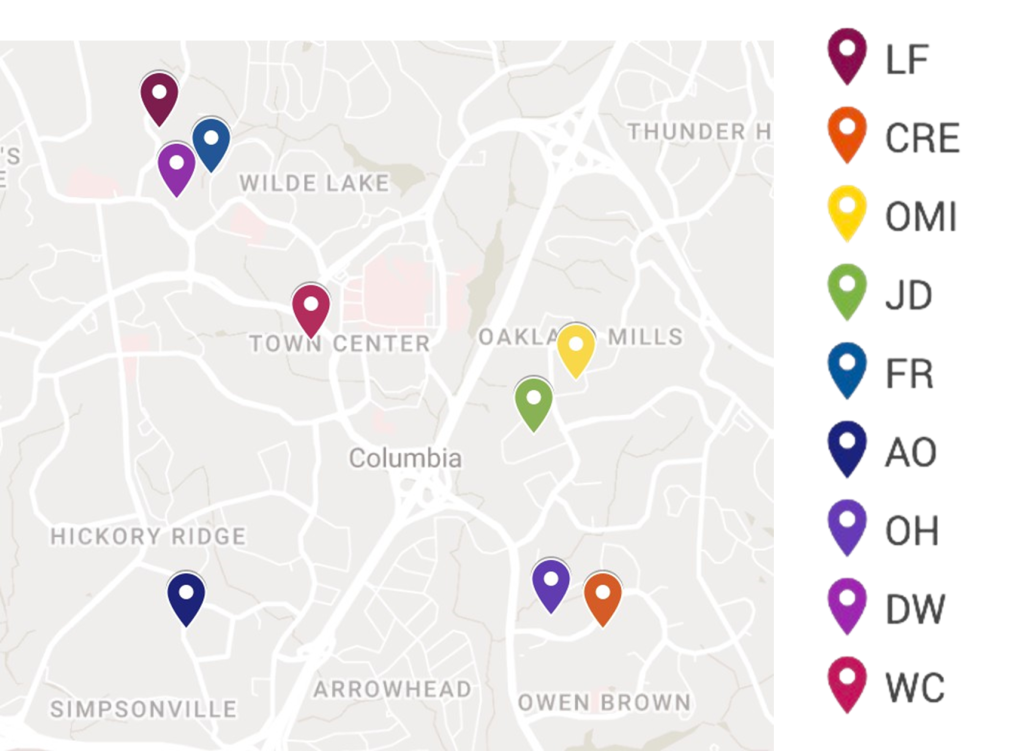
Figure 1: Location of all nine sites across Columbia, MD.

Table 1: Table of the species planted at each site.
Both insect and human sets of data were collected from June to November 2024. For the insect data set, a procedure was adapted from a similar study in which the researcher stood in the same place during each visit and counted how many insects they saw in one minute [10]. This method was selected to measure the abundance of both bees and other flying insects at each site. Visits were conducted under ideal weather conditions, which were sunny or partly cloudy with no precipitation. General weather conditions needed to remain the same across visits, as data collected during different weather conditions would reflect impacts based on weather instead of impacts based on plants. Visits were conducted on an approximately weekly basis and all sites had one pre-garden data point. Multiple photos of the sites were taken during visits. Starting with the third round of visits, a hand-width was used as a scale reference in order to visually track general growth trends of the plants.
Regarding the human participants, the research aimed to measure how engaging community members in planting and maintaining native gardens affected their thoughts, attitudes, and actions surrounding native plants. This was done by having two IRB-certified surveys of the participants: a pre-garden survey taken before the garden was planted and a post-garden survey taken in November after the participants had cared for the gardens throughout the 2024 growing season. Likert scales ranging from 1-5 (1 was negative while 5 was positive) were used for the survey question responses in order to best compare the pre- and post-data. Participants were given instructions prior to the garden installation regarding maintaining the gardens, such as watering, weeding, potential clean up, and what to expect in future years as the gardens mature.
Results
It was found that while bee and flying insect visitation did increase in comparison to pre-garden numbers, the data varied greatly from site to site, most likely due to the varied environmental conditions and a correlation to the presence of impervious surfaces, such as asphalt or concrete (Table 2).

Table 2: Flying insects and bees at each site per visit date. “0” date represents data collected before the garden was installed.
Positive and negative controls were added during the third visit. The positive control was a mature native garden located on OMI’s property, and the negative control was a maintained grass lawn also located on OMI’s property. Surveyed areas for each control are outlined in red and are approximately 50 square feet (Fig. 2). The general trend from the controls is that the positive control was consistent at attracting flying insects, especially bees, while the grass lawn was more sporadic. Additionally, insects found on the positive control had a clear use for the plants, as they were visiting the flowers. Sites that mimic the negative control are CRE, OH, OMI, JD, and AO, while sites that mimic the positive control are WC, FR, DW, and LF. The sites that are more similar to the negative control are also sites located closer to impervious surfaces, while sites that are more similar to the positive control are located near more natural areas.
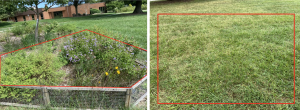
Figure 2: Left shows the positive control mature native garden. Right shows the negative control grass lawn.
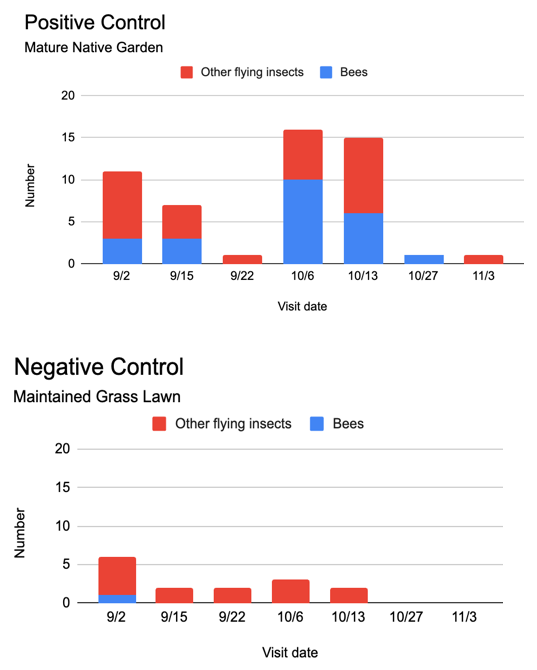
Figure 3: Data from the positive and negative control sites. Control sites have the same conditions and are located at the same facility. Monitored portion of the control sites was roughly the same as gardens (~50 sq ft).
The human data set was less variable, and metrics increased in line with the hypothesized outcomes across the board from the pre to post-survey. People’s self-reported knowledge of native plants increased substantially (Fig. 4), their overall view of native plants increased positively (Fig. 5), they favored environmental impacts of plants over aesthetics (Fig. 6), and they were more likely to pay attention to the origin of plants before making hypothetical purchases (Fig. 7). As a note, one extra participant took the pre-survey (n=10), but did not complete the post-survey (n=9).
While participants were educated about native plants and their benefits during the garden installation process and were provided an electronic handout, the dramatic increase in self-reported knowledge on native plants is impressive. The pre-survey’s average was a 2.9, while the post-survey’s average was a 3.8, where no one reported anything below a 3 (Fig. 4). The reason the number of responses of 5 may have decreased is that people forgot what they had reported on the pre-survey, or as they continued to seek out information on native plants, they realized that their previous scope of knowledge was limited. Nonetheless, this suggests that people did research on their own to educate themselves about native plants. This might have affected the rest of the results, as the more they researched, the more they learned about the ecological importance of native plants.

Figure 4: Participants knowledge of native plants. Knowledge of native plants increased.

Figure 5: Pre (left) vs. Post (right) view of native plants. One hundred percent of people in the Post survey rated their view of native plants as extremely positive, compared to 90% in the Pre survey.
People’s potential purchases changed because of the gardens, with more people reporting that they consider environmental impacts more than just aesthetics (Fig. 6) and most were very likely to pay attention to plant species’ place of origin before purchasing them (Fig. 7) There was also a 20% increase in the number of people who reported that they had a native plant in their yard (Fig. 8). This means that because people engaged with native plants, they intentionally sought out native species to purchase for their own landscaping. These results have broader implications for the landscaping market and could increase native plant sales while decreasing exotic and invasive plant sales.

Figure 6: Environmental vs. aesthetic considerations when purchasing plants. People are more likely to consider environmental impacts over aesthetics after their experience with the gardens.

Figure 7: Pre (left) vs. Post (right) survey measuring the likelihood to pay attention to where a plant comes from and its role in an ecosystem before purchasing it. People are more likely to pay attention to species origin and ecosystem roles when buying plants.
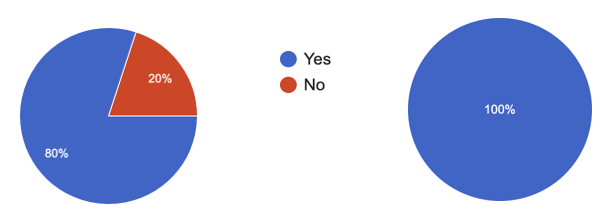
Figure 8: Pre (left) vs. Post (right) survey results where participants were asked if they had any native plants in their yard. There was a 20% increase in the number of people who responded “yes”.</>
Additionally, participants were asked to rate how connected their community felt as a direct result of the garden. Because of the gardens, community connectivity increased. The pre-survey’s average response was a 3.3, while the post-survey’s average response was a 3.6 (Fig. 9). When people have a common goal to care for something, it brings them together and causes people to build connections in their community, as multiple participants reported that the gardens increased community engagement (see Appendix).

Figure 9: How well participants felt their community was connected, specifically in relation to this project. People felt that their community was more connected because of the gardens.
Discussion
The findings suggest that when communities are engaged with the native garden process and subsequent care, they are more likely to have a positive view of native plants, incorporate them into their landscape, and spearhead community plantings of their own. This outcome has already been seen with the research site FR, as the participant wrote, “The project helped to springboard and contribute to larger efforts to eliminate invasives.” The community has since removed all of the invasives from their hillside and collaborated with their local community association to create an “Adopt-a-Spot” native garden at the bottom of their property (Fig 10).
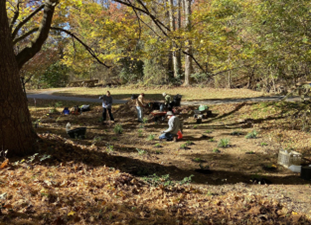
Figure 10: FR community planting an Adopt a Spot adjacent to research site in the fall.
Impervious surfaces seem to play a role in how insects find native plants. Sites that were surrounded by or located near impervious surfaces saw far fewer insects than those in or near pervious surfaces (data shown in Appendix). These sites’ data is more closely aligned with the negative control data. It is possible that being located adjacent to natural environments that support insects improves the likelihood of insects finding a new habitat source (garden). Since this data is just from the first year, it is expected that as the plants mature and flower, more insects will find them and use them for reproduction, increasing the amount of insects using the gardens.
Flowers may also not be the biggest factor that attracts insects, as many sites had flowers but did not see an increase in insect visits. The only flower to significantly impact insect visits was the blue wood aster at WC. This may be because of the sheer volume of flowers, the large number of species the plant is known to support, and/or being surrounded by pervious surfaces.
Plants
Growth of the plants varied greatly, both between sites and between plant species. While no measurements were officially taken, a hand was used for scale to visually track general growth trends. In general, plants that were already established in soil prior to planting performed better than those that were bare root at the time of planting. It is recommended that plants are either purchased/sourced as soil-established plants or that plants are planted in a soil medium and rooted out before planting as opposed to being stored as bare root and then planted at the site.
Some plants outperformed others. Two species of note that bounced back from presumable death were golden ragwort (Packera aurea) and moss phlox (Phlox subulata). Packera aurea, despite being planted bare root, survived at all sites it was planted at and spread throughout the growing season. It grew in all site conditions, from dry and sunny (OH) to moist and shady (FR). As it is a groundcover plant, it is expected to spread throughout the following years to create a living mulch.

Figure 11: From left to right: Packera at DW site spreading, Packera with signs of insect usage at LF, and Packera at FR.
Moss phlox was only planted at the OH site as a bare root and struggled throughout the brutal heat of summer but notably started to put on more vegetative growth during fall.
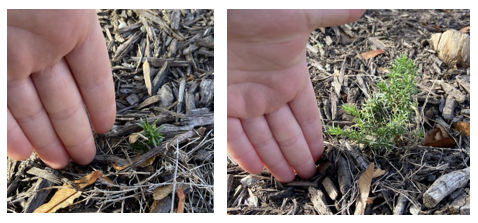
Figure 12: Comparison of growth of moss phlox at OH.
Foxglove beardtongue (Penstemon digitalis) performed well at most sites, putting on foliar growth in both sunny and shady conditions. All three of the previous plants mentioned bloom around spring-early summer, so they did not bloom the first year and instead focused on foliar growth.

Figure 13: From left to right: Penstemon digitalis at AO, OMI, WC, and OH.
Orange coneflower (Rudbeckia fulgida) performed well at the OH site, which was the only site it was planted in. They were planted as quart sizes and didn’t seem to do well until fall, which welcomed rain and cooler temperatures. These plants bloomed the longest, from September to November.
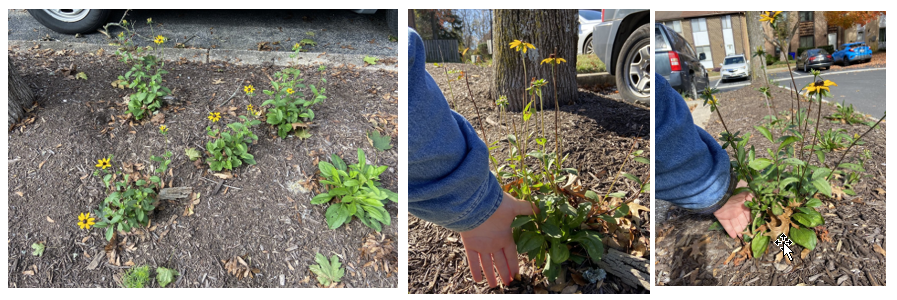
Figure 14: Left shows orange coneflower in bloom at OH site during September. Comparison of shady-side (middle) and sunny-side (right) growth of orange coneflower.
Blue wood aster (Symphyotrichum cordifolium) was the most prolific plant in terms of flower production. When it bloomed in fall, it was approximately five feet tall and covered in small blue flowers that attracted a plethora of flying insects. For immediate positive results for pollinators, most species of asters are recommended, as they will bloom the same year they are planted with a high amount of flowers.

Figure 15: Left shows an insect pollinating blue wood aster. Middle shows the height of blue wood aster. Right shows the mass of blooms from three plants.
This same logic can also be applied to many species of goldenrods (Solidago). Solidago altissima and flexicaulis bloomed during the fall, but Solidago altissima was much shorter than the expected 6-9ft tall plants, as it was only about 1.5ft tall. Another late season bloomer that flowered was great blue lobelia (Lobelia siphilitica).
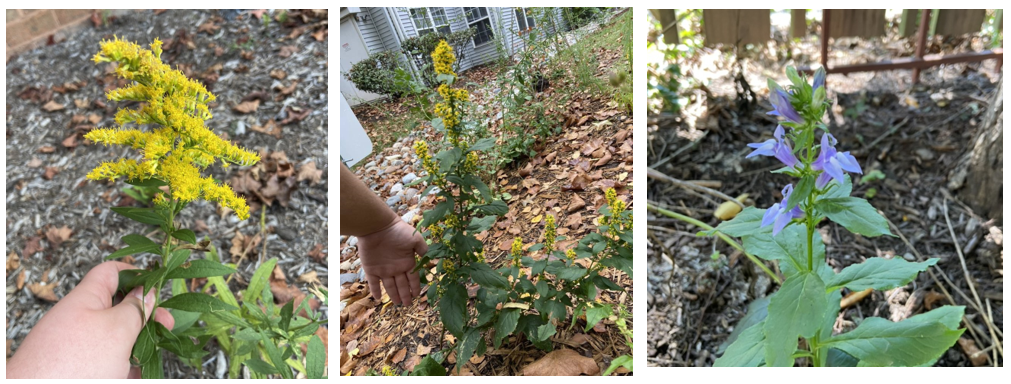
Figure 16: Left shows Solidago altissima at OMI. Middle shows Solidago flexicaulis at WC. Right shows great blue lobelia at DW.
In general, plants that have later bloom times should be planted for immediate first-year impacts of native gardens. Aster and goldenrod species are of particular interest because of their performance in this study, as well as being keystone species.
Conclusion
The results have profound implications for the future of native plants, sustainable landscaping, and shifting cultural norms regarding gardens in America. While this study only focused on growth in a single year, these gardens are expected to significantly increase in plant biomass and subsequently insect visitation, as more insects will find these gardens and use them for food, shelter, and reproduction. It is thought that as the gardens mature, people’s attitudes will continue to favor native plants as they care for the gardens and see the interactions between wildlife and plants flourish. This could also encourage more community members to engage with the native gardens, leading to continued community support for native plants, increasing habitat, and decreasing lawns and invasive plants.
A future study could investigate how the garden’s distance from impervious surfaces and overall impervious surface cover affects insect abundance over time, as it was found that sites located near or surrounded by impervious surfaces had overall lower insect visits than those surrounded by previous surfaces. This could give insight into where native gardens should be planted within a community to maximize the ecological potential of the garden. Additionally, time of planting may be a factor. Planting gardens in spring or fall would help to avoid the high summer temperatures and potential droughts while the plants become established.
Because the project was self-funded, considerable time was focused on sourcing plant species at varying stages of development and there was a limited amount of time to monitor the nine widely-spaced garden sites. Receiving funds to procure plants at more similar stages of growth prior to planting, as well as personnel to travel to and collect data from the gardens, would have also made it possible to collect a larger range of plant data, such as height and spread over time.
A limitation of the field data method used was that it was difficult to tell insects apart from the observing distance, so some data may be unreliable (as in some bees may have been grouped into the other flying insect group and vice versa). Additionally, on the few days when there was high insect abundance, keeping track of the count of each group proved difficult.
Future studies should aim to use a capture-and-ID method for measuring insect abundance, where researchers collect insects from the sites, then bring those insects back to a lab to identify them. This would allow researchers to clearly identify which insects were and were not bees, as well as identify if those insects were native or non-native to the region and if they were specialists or generalists.
Another possible direction would be to see how people’s attitudes and actions change depending on the price of a garden. It is worth considering if people would care more for one that they paid a small sum for because they had a monetary investment or if a monetary price would drive away interest. Additionally, another study could investigate how the resources provided to participants influence their overall experience with the gardens, and subsequently, how they view native plants. It is hoped that continuing this line of research will eventually lead to increased funding towards making native plants more accessible to communities which, when compounded, could lead to increased ecosystem services and biodiversity, thus creating a healthier and safer environment for us all.
Acknowledgements
All the native plants in the gardens were donated, making this all possible. A huge thank you is given to all the native gardeners who supported this effort by donating their plants: Howard Gordin, Alina Sopiep, Julie Danna, Bess Caplan, Catherine Berruer Ojo, Stephanie Bills, Susie Kantt, Dianne Beer Maxwell, Bena Zhang, Kathy Kaberle, Carol Fain, Cassandra Hostetler, Wendy Hall, Alicia Eugenia Ardila, Jamie Modico, Martha Betz, Katie Schmitt, Barbara Ridler White, Phannie Truong, and Erica Leventhal. The following people are recognized for their considerable contributions on behalf of their respective organizations: Don Georgette (Sustainable Landscapes VA-MD), Natalie Yee (Columbia Association), and Julie Costantino (Howard County Bee City). A special thank you is given to the Facebook groups of “Maryland Gardening for the Environmentally Conscious” and “Howard County Gardeners”. The participants’ hard work and continued efforts into caring for the gardens and maintaining them for years to come is also recognized.
Contact: andrew.heffner@howardcc.edu
Appendix
Please scan the QR Code below to view an electronic version of the Appendix. It includes detailed information on each of the nine research sites, including location, environmental conditions, site preparation, notes, participant comments, and photos.

References
[1] B. R. Beckwith, E. M. Johansson, and V. J. Huff. “Connecting people, plants and place: A native plant society’s journey towards a community of practice.” People and Nature, vol. 4, no. 6, Jun. 2022, doi: https://doi.org/10.1002/pan3.10368.
[2] C. A. M. Marshall et al. “Urban wildflower meadow planting for biodiversity, climate and society: An evaluation at King’s College, Cambridge.” Ecological solutions and evidence, vol. 4, no. 2, Apr. 2023, doi: https://doi.org/10.1002/2688-8319.12243.
[3] N. Seitz, D. vanEngelsdorp, and S. D. Leonhardt. “Are native and non‐native pollinator friendly plants equally valuable for native wild bee communities?” Ecology and Evolution, vol. 10, no. 23, Oct. 2020, doi: https://doi.org/10.1002/ece3.6826.
[4] K. Berthon, F. Thomas, and S. Bekessy. “The role of ‘nativeness’ in urban greening to support animal biodiversity.” Landscape and Urban Planning, vol. 205, no. 103959, p. 103959, Jan. 2021, doi: https://doi.org/10.1016/j.landurbplan.2020.103959.
[5] Amano, I. Butt, and K. S.-H. Peh. “The importance of green spaces to public health: a multi-continental analysis.” Ecological Applications, vol. 28, no. 6, pp. 1473–1480, 2018, Available: https://www.jstor.org/stable/26623246.
[6] L. Smallwood and E. M. Wood. “The ecological role of native‐plant landscaping in residential yards to birds during the nonbreeding period.” Ecosphere, vol. 14, no. 1, Jan. 2023, doi: https://doi.org/10.1002/ecs2.4360.
[7] Arnaud Ameline, C. Thomas, C. Marion, D. Jean, and D. Guillaume. “How generalist insect herbivores respond to alien plants? the case of Aphis fabae ‐ Myzus persicae ‐ Rhododendron ponticum.” Pest Management Science, vol. 80, no. 4, Dec. 2023, doi: https://doi.org/10.1002/ps.7908.
[8] Masierowska. “Urban Bees Benefit from a Native Forest Species Grown in a City Environment–A Case Study of Geranium Phaeum L.” Journal of Apicultural Science, vol. 65, no. 2, pp. 331–343, Dec. 2021, doi: https://doi.org/10.2478/jas-2021-0024.
[9] J. Warren, S. Noezil, and C. Mokadam. “Non-native plants rarely provide suitable habitat for native gall-inducing species.” Biodiversity and Conservation, vol. 30, no. 10, pp. 2797–2805, Jun. 2021, doi: https://doi.org/10.1007/s10531-021-02222-7.
[10] Salisbury, J. Armitage, H. Bostock, J. Perry, M. Tatchell, and K. Thompson. “Enhancing gardens as habitats for flower-visiting aerial insects (pollinators): should we plant native or exotic species?” Journal of Applied Ecology, vol. 52, no. 5, pp. 1156–1164, Aug. 2015, doi: https://doi.org/10.1111/1365-2664.12499.
[11] Isbell et al. “Expert perspectives on global biodiversity loss and its drivers and impacts on people.” Frontiers in Ecology and the Environment, vol. 21, no. 2, Jul. 2022, doi: https://doi.org/10.1002/fee.2536.
[12] Kumar Rai and J. S. Singh. “Invasive alien plant species: Their impact on environment, ecosystem services and human health.” Ecological Indicators, vol. 111, no. 0, p. 106020, Apr. 2020, doi: https://doi.org/10.1016/j.ecolind.2019.106020.
